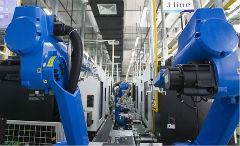Technology brings about new era in China’s manufacturing sector
2017-10-20
cgtn.com
Polishing glass lenses, sewing stuffed toys, and making cell phone protective cases — China’s huge population of skilled workers and cheap labor propelled the country to become the world’s factory over the past two decades.
But things took a turn when suddenly, many Chinese manufacturers found they were lagging behind their global competitors and market demands.
Zeng Zhiyong, general manager of German company Carl Zeiss Vision Tech (Guangzhou) Ltd told CGTN that in 2012, the Zeiss Group informed him that labor in China was twice as expensive as in Mexico and four times the cost in India.
“In early 2015, we signed around 20 big deals. But by the end of that year, lots of clients had canceled orders, and we only had three orders left. We knew we had a big problem,” said Huang He, general manager of Janus Precision Manufacturing in Dongguan, South China’s Guangdong province.
Since then, robots and automated machines have been introduced to factories on a massive scale.
In a Chinese factory for Carl Zeiss, robots reduced the cost per lens to the lowest of all the Zeiss factories in the world.
“In 2012, the factory had 440 workers producing 4 million lenses every year. In 2015, the number of workers decreased by 70 people, but output increased to 5 million,” Zeng said.
Some firms, such as Janus Precision, even took it a step further: building an unmanned factory, boasting 160 automated machines and no workers — relying solely on robots to carve metal plates without human instruction.
“The whole manufacturing process is connected on the cloud. Now we can monitor all the real-time statistics and the situation inside the factory,” said Huang.
In 2015, the Chinese government issued the “Made in China 2025” strategy, encouraging intelligent manufacturing.
Later that year, President Xi Jinping brought forward the idea of “supply-side reform,” vowing to upgrade China’s manufacturing sector.
“We’ve been talking about economic transformation for many years, but I think the real change started two years ago,” Professor Liang Qi, an expert in economic transformation and industry planning at Sun Yat-Sen University, told CGTN.
In the past decade, China’s real economy went through a difficult time as many entrepreneurs chose to leave the manufacturing sector for the financial or property sectors. But from Liang’s observation, now the real economy is gradually regaining hope and confidence.
The primary contradiction facing Chinese society is unbalanced and inadequate development, and at the same time, the people’s ever-growing need for a better life, Xi said in a report to the 19th CPC National Congress on Oct 18.
Professor Liang said the new type of industrialization is a crucial part of the solution because the new fortunes created in this process can be used to support the development of underdeveloped regions.



